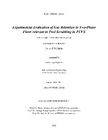Experimental Evaluation of Gas Retention in Two-Phase Flows relevant to Pool Scrubbing in FCVS

Open access
Author
Date
2022Type
- Doctoral Thesis
ETH Bibliography
yes
Altmetrics
Abstract
The safe operation of a nuclear power plant (NPP) has the highest priority for the owning utility. Therefore, safety measures must be in place for the anticipation of different, sometimes very challenging or even severe, accident scenarios. As part of the installations to mitigate the consequences of severe accidents, filtered containment venting systems have been developed in the past and installed to protect the containment from integrity failure due to over pressurization after a core damage. The designs of nowadays filters rely either on dry filters (sand bed, metal fiber or zeolite filters) or wet scrubbers. In case of wet scrubbers, the efficiency for scrubbing contaminants from the gas stream is depending, among other parameters, on the hydrodynamic properties of the flow, chemical composition of the scrubber solution and additional internal structures for enhancement of the mixing.
The removal of iodine species has not been an easy task for wet scrubbers so far. Several studies tried lately to link the removal efficiency of iodine to different quantities like gas injection velocity, bubble residence time and iodine concentration in the contaminated gas stream or gas temperature applied to different gas inlet nozzle designs. In the field of the soluble gas models, which are part of the models dealing with the retention of gaseous iodine variations, the available data set were rather scarce to validate the codes, which use those correlations. Furthermore, the tests conducted to benchmark these codes laid their focus on suppression pools, i.e. rather simple nozzles, and using a high share of steam where condensation is having a big impact on the flow field and trapping. In the bubble rising zone, the regime of a homogeneous bubble column is assumed to establish after the injection. In reality, especially for filtered containment venting systems, the high volumetric flow rates can lead to very heterogeneous and chaotic flow behavior that is not well captured by the existing models.
The aim of this work was to characterize the established two-phase flow structure for two typical filtered containment venting system nozzles, i.e. a Venturi design and a simple converging nozzle with impaction plates combined with a bubble breaker. The main instrumentation utilized for this purpose were wire-mesh sensors in two different facilities, TRISTAN and ISOLDE, at the Paul Scherrer Institut. Furthermore, a new methodology for high-speed shadowgraphy was proposed and applied to measure droplet sizes inside the throat of self-priming Venturi nozzles. The adiabatic conditions and non-condensable gases, dry nitrogen or compressed air, were chosen on purpose to disentangle the very complex mechanisms of pool scrubbing and focus on the pure soluble gas diffusion.
The measured droplet sizes and the corresponding Sauter mean diameter in the Venturi design suggest to rather focus on annular flow based correlations than common Venturi correlations from the chemical field due to the unique self-priming operation mode. In the pool, the heterogeneous flow fields that came forth in both nozzle designs at the most probable flow rates made a closer look at mass transfer phenomena necessary.
Carbon dioxide was used as a substitute for inside a small-scale bubble column with 50 x 50 mm2 cross-section at ETH Zürich to investigate the effect of the flow structure on the mass transfer. For these tests, a new methodology for mass transfer experiments was developed, using wire-mesh sensors for both, two-phase flow structure characterization and measurement of the scrubbed gas concentration in the liquid. The results showed a high contribution from smaller bubbles in the mass transfer process whereas Taylor bubbles are not strongly participative. The new gained data on the spatio-temporal evolution of the concentration of the dissolved gas was used to extract mass transfer coefficients with the help of a one-dimensional code based on the continuous stirred tank and the axial dispersion model. The simultaneous measurement of mass transfer and interfacial area allowed to separate mass transfer coefficients from the interfacial area concentrations. The model could be further developed in the future with more experimental data especially at lower gas concentrations relevant to pool scrubbing and eventually molecular iodine tests. Show more
Permanent link
https://doi.org/10.3929/ethz-b-000568575Publication status
publishedExternal links
Search print copy at ETH Library
Contributors
Examiner: Prasser, Horst-Michael
Examiner: Rudolf von Rohr, Philipp
Examiner: Herranz, Luis E.
Publisher
ETH ZurichSubject
Two-Phase Flow; Filtered Containment Venting; Mass transfer coefficient; Wire-mesh sensor (WMS); Shadowgraphy imaging; Droplet Size; bubble size distribution; Void fraction measurement; Venturi Scrubber; Bubble ColumnOrganisational unit
03725 - Prasser, Horst-Michael (emeritus) / Prasser, Horst-Michael (emeritus)
More
Show all metadata
ETH Bibliography
yes
Altmetrics



